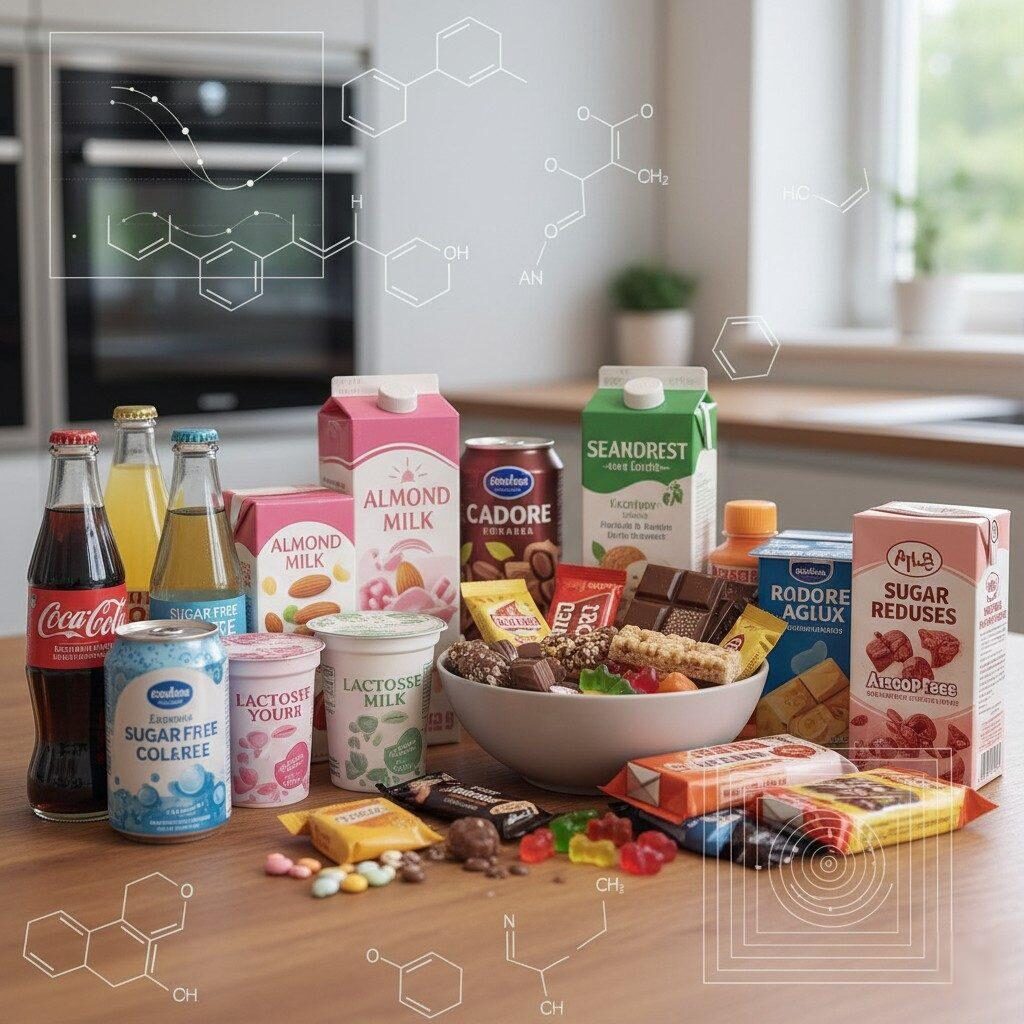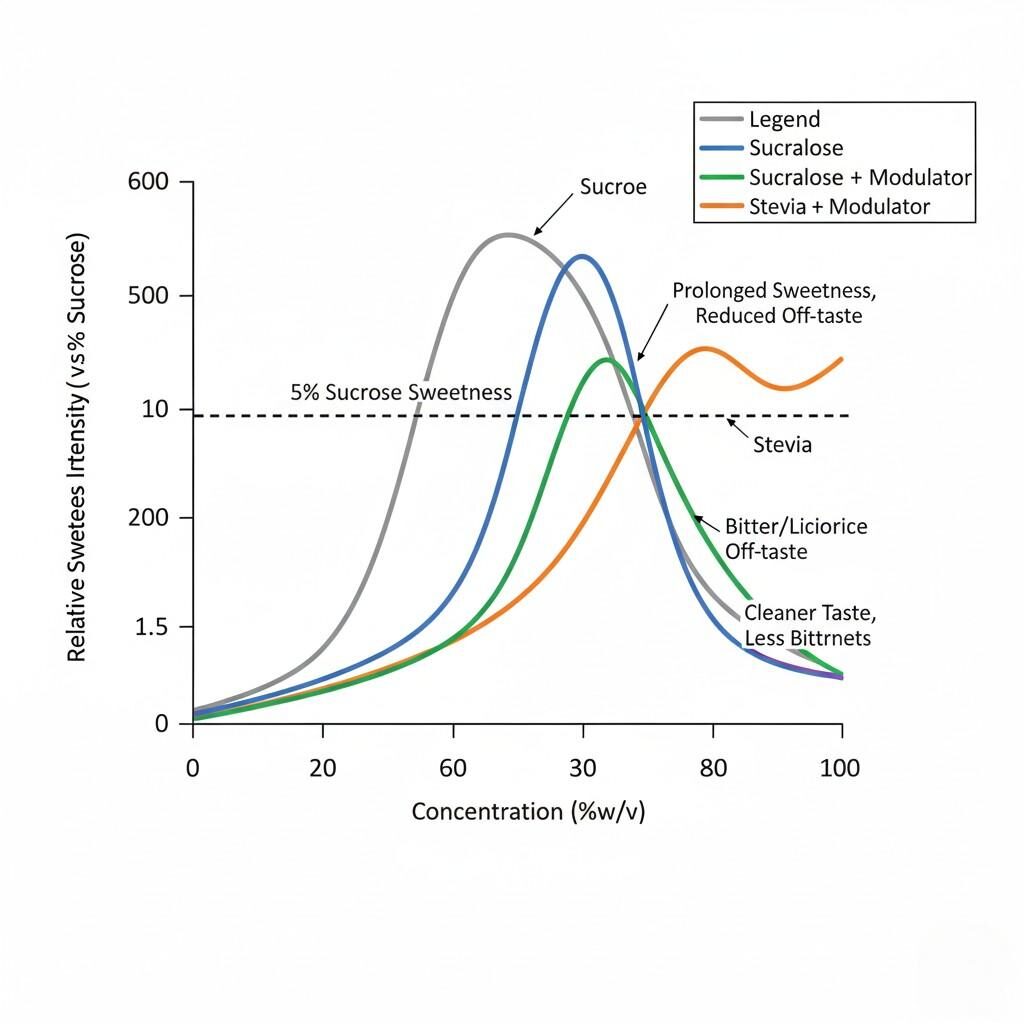Author: R&D Team, CUIGUAI Flavoring
Published by: Guangdong Unique Flavor Co., Ltd.
Last Updated: Nov 19, 2025

Sugar-Reduced Products with Chemical Overlays
The global food and beverage industry is undergoing one of the most significant reformulations in its history. Governments are implementing sugar taxes, consumers are demanding healthier options, and brands are competing to maintain great taste while delivering cleaner labels and lower-calorie profiles. According to the World Health Organization (WHO), high sugar intake is strongly associated with obesity, diabetes, and cardiovascular disease, prompting increasing global initiatives to reduce added sugars in packaged foods¹.
However, reducing sugar is not simply a matter of lowering sucrose percentage. Sugar contributes multiple sensory and functional roles beyond sweetness, including:
Thus, the food industry faces a core challenge: How do we reduce sugar without compromising the eating experience?
This is where sweetness modulators—also known as flavor modifiers or sweetness enhancers—play a transformative role. These compounds, often used at very low dosages, can extend sweetness, rebalance flavor profiles, block bitterness, enhance aroma perception, and recreate the roundness and mouthfeel typically delivered by sugar.
This article provides a comprehensive and technically detailed overview of how sweetness modulators work, the science behind them, regulatory perspectives, product application strategies, and how modern flavor houses—including advanced manufacturers like us—develop integrated solutions for sugar-reduction systems.
At over 3,000 words, this article is written for food R&D professionals, formulators, sensory scientists, and technical buyers seeking deep insight into one of the fastest-growing segments of modern food innovation.
Sweetness is fundamentally a chemosensory response involving receptors in taste buds—primarily T1R2/T1R3 heterodimers. When sucrose or other sweet molecules bind to these receptors, they trigger signaling pathways that the brain interprets as sweetness.
But the perception of sweetness is influenced by far more than receptor activation alone.
Sweetness intensity and quality depend on:
This complex sensory network means that replacing sucrose with a single high-intensity sweetener (HIS) like sucralose or stevia rarely recreates sugar’s full sensory impact.
Sugar contributes:
Alternative sweeteners often fall short due to:
These gaps create opportunities for sweetness modulators to reshape the profile.
Sweetness modulators are non-sweet or minimally sweet ingredients that modify how sweetness is perceived. They do NOT simply add sweetness; instead, they enhance, extend, balance, or reshape the sweetness profile of a product.
Together, these tools allow food formulators to achieve up to 40–70% sugar reduction without sacrificing taste.
Certain natural flavor compounds can bind to or influence T1R2/T1R3 receptors, making them more responsive to sweetness stimuli. These enhancers often work synergistically with HIS, allowing formulators to reduce sweetener load while improving taste quality.
Modulators can:
This allows the sweetness curve to more closely mimic sucrose.
Key targets for masking include:
Sweetness modulators can neutralize these issues and improve flavor perception.
Research from the Monell Chemical Senses Center confirms that certain aromas—fruity, vanilla, caramel—significantly increase perceived sweetness without increasing sugar².
This phenomenon is widely used in beverage and dairy formulations to deliver sweetness enhancement via strategic flavor design.
Sugar contributes up to 60% of perceived body in beverages. Technical approaches to mouthfeel enhancement include:
This multi-layered system recreates the body lost when sucrose is removed.
Below is a deeply technical classification used in global R&D laboratories.
These compounds, often derived from plants, fruits, or fermentation processes, subtly boost sweetness without contributing significant sugar.
Examples include:
Many of these are considered natural under major regulatory frameworks, depending on region.
These are precision-designed molecules engineered for specific sensory effects:
These are typically used at ppm levels and can dramatically improve the taste of HIS.
Aromas that naturally evoke sweetness:
Even when used below flavor threshold, they can increase perceived sweetness by 10–20%, according to the Journal of Food Science³.
Sugar reduction often requires bulk replacement to retain mouthfeel.
Common functional bulk replacers include:
Allulose has recently gained attention, as the FDA determined it no longer needs to be counted as “added sugar,” encouraging widespread use in U.S. reformulations⁴.

Sweetness Curves: Sucrose vs. High-Intensity Sweeteners
Challenges include:
Sweetness modulators help:
A common formulation approach:
Challenges:
Solutions:
Plant-based milk sees exceptional benefits from modulator systems, which can remove “beany” notes and increase perceived sweetness.
Sugar functions as:
Sweetness modulators enhance:
Using modulators with allulose or isomalt can yield sugar-like browning and texture in applications.
Sweetness helps balance:
Sweetness modulators can:
Even small adjustments can improve the perception of realness and freshness.
Regulations vary between jurisdictions, but most modulators fall into categories such as:
Relevant references:
Natural modulators (e.g., fruit-derived compounds) often have broader acceptance across markets due to cleaner labeling requirements.

Sensory Panel Evaluating Reduced-Sugar Products
Different levels require different strategies:
Each category has unique challenges:
Advanced modulators must be tailored to each system.
Using techniques like:
This ensures that the reduced-sugar version matches full-sugar benchmarks.
Sugar acts as:
When removed, reformulation must ensure stability remains consistent.
Aromas must match sweetness strategy:
Flavor houses often design the entire sweetness + aroma system as a unified solution.
Bioconversion technologies now produce modulators from:
These meet natural labeling requirements and offer clean taste profiles.
New-generation systems combine:
These synergistic blends offer unparalleled sugar-like performance.
Allulose’s global acceptance is accelerating, especially due to FDA’s exemption from “added sugar” labeling⁴.
Modulators improve its mild sweetness and temporal curve.
Rebaudioside M offers clean sweetness but requires modulators to optimize cost and flavor.
Machine learning tools predict:
This accelerates development cycles and lowers R&D costs.
Challenges:
Solution:
Challenges:
Solution:
Challenges:
Solution:
As a professional manufacturer of food-grade flavorings and functional modulators, our R&D approach includes:
Our sweetness modulator systems help brands achieve:
Sugar reduction is no longer optional—it is a global regulatory, consumer, and market-driven necessity. Sweetness modulators offer a powerful solution to bridge the sensory gap left by sugar reduction, enabling food and beverage developers to maintain excellent taste while delivering healthier, cleaner-label products.
The most successful sugar-reduction strategies are multi-dimensional, combining modulators, aroma design, bulking agents, and advanced sensory science to recreate full-sugar quality.
Whether your category is beverages, dairy, bakery, sauces, or confectionery, sweetness modulators provide a pathway toward innovation and healthier consumer choices.

Reduced-Sugar Products & R&D Collage
If your team is working on sugar-reduced or zero-sugar reformulation, we offer:
✔ Technical consultation
✔ Customized sweetness modulation design
✔ Application support for beverages, dairy, bakery, snacks, and more
✔ Free professional flavor samples for qualified R&D teams
Contact us for expert support in your next reformulation project.
📧 Email: [info@cuiguai.com]
🌐 Website: [www.cuiguai.cn]
📱 WhatsApp: [+86 189 2926 7983]
☎ Phone: [+86 0769 8838 0789]
Copyright © 2025 Guangdong Unique Flavor Co., Ltd. All Rights Reserved.